
Today we can present a new case: a lively, neighbourhood street with a name unpronouncable to foreigners (like most streets in Copenhagen): Værnedamsvej.
Værnedamsvej is a lovely little street lined with small shops and cafés/restaurants. These businesses and the French school, with around 800 students, create a bustling environment. Years ago the street was nicknamed Butchers Street (Slagtergade) because of the many meatmongers. Now, because of the French restaurants and the school, it's nicknamed The French Street.
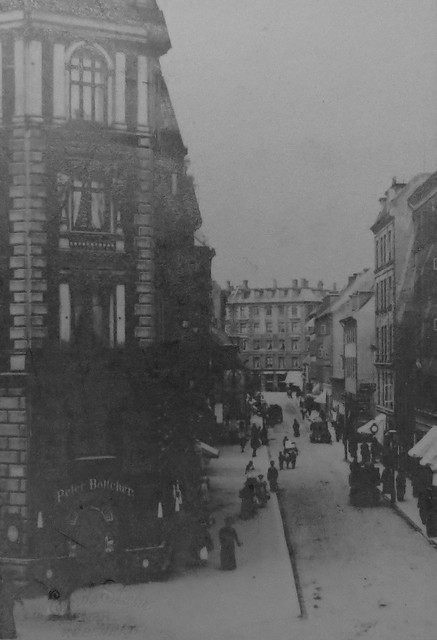

One of the street's intrinsic features is that the border between the municipalities of Copenhagen and Frederiksberg zig zags down the street. Few people know where the border runs and it doesn't really matter to them - or to us. This municipal divide has been the reason, however, that the street hasn't been redesigned and modernised. There has been talk of it for a couple of decades, but the two municipalities haven't been able to figure it out.
The street has a fantastic old-school neighbourhood feel but it is also a key route between the two municipalities. There are many cyclists using the street on their A to B journeys despite the lack of infrastructure. Regular bikes and cargo bikes. Also, the many pedestrians suffer from hopelessly narrow sidewalks.
Here is a brief technical description of Værnedamsvej:
-
190 meters long and 12 meters wide;
-
link between two main streets (Gammel Kongevej and Vesterbrogade – both are two-way streets with cycle tracks)
-
connected to the main street Frederiksberg Allé
-
a part of the street is one-way for cars and the other is two-way for cars
-
there is no dedicated infrastructures for bicycle users (no bike lane or even bike racks).
This street is one our favourites in the city and we've been looking at it for ages. Finally, the two municipalities have decided to do something about it and a redesign is in process. We thought we would analyse the street ourselves.
Redesigning the street is one thing. It works relatively well as it is. Bizarrely, it's a 50 km/h zone, but the many pedestrians and cyclists serve to slow it right down to a human speed. We have been looking at the street itself, but we quickly realised that whatever redesign ends up in place, it is completely and utterly irrelevant unless the two intersections at either are dealt with first.
The southern intersection is one of the biggest brain farts in Copenhagen. It's a nightmare and completely ignores the natural Desire Lines of cyclists and pedestrians. The intersection also straddles the municipal border, so that probably explains the fall of reason and the rise of half-hearted municipal comprimise.
At the corner of Værnedamsvej, Vesterbrogade and Frederiksberg Allé, cyclists simply cannot cross the intersection “legally”. They must use through a car lane with oncoming, turning cars or get off their bike (in principle) and pretend they are pedestrians, using the two-stage crossing.
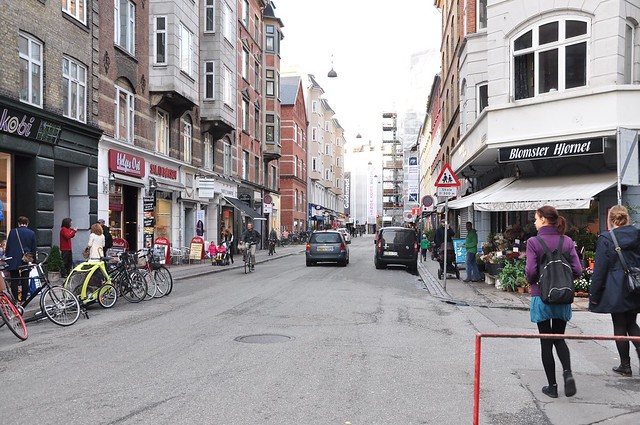
To redesign this street, Copenhagen and Frederiksberg municipalities need to work together. This street deserves it. It is a model of lively and meaningful urban atmosphere in a dense, residential district. It's a life-sized street, nestled in between two main boulevards. With a few rearrangements people would enjoy the urban life in even better conditions.
We're pleased that the two municipalities have finally agreed to act. We're all for it. In our point of view, however, the first thing to do to improve this street is to fix the intersections. After that, the street can be tackled.
We tracked the Desire Lines of the bicycle users and mapped them and now we're going to proposed solutions based on these important factors.
Part 2: The Desire Lines tool applied to an asymmetric intersection (Værnedamsvej, Gammel Kongevej, Svanholmsvej)

The northern intersection is a bit odd and rather asymmetrical. It is also clearly very car-centric. By applying our Desire Line tool, we quickly discovered that there are a variety of unconvential ways that bicycle users emply to cross it. Here are the results of our observations.
Northern intersection - Heading out of Værnedamsvej
The map shows the cyclists leaving Værnedamsvej at the northern intersection. On this morning in November 2013, 381 bicycle users went through the junction between 07:30 and 08:30. There are three basic directions they headed in:
-
heading straight down Svanholmsvej
-
making a left turn up Gammel Kongevej
-
making a right turn down Gammel Kongevej.
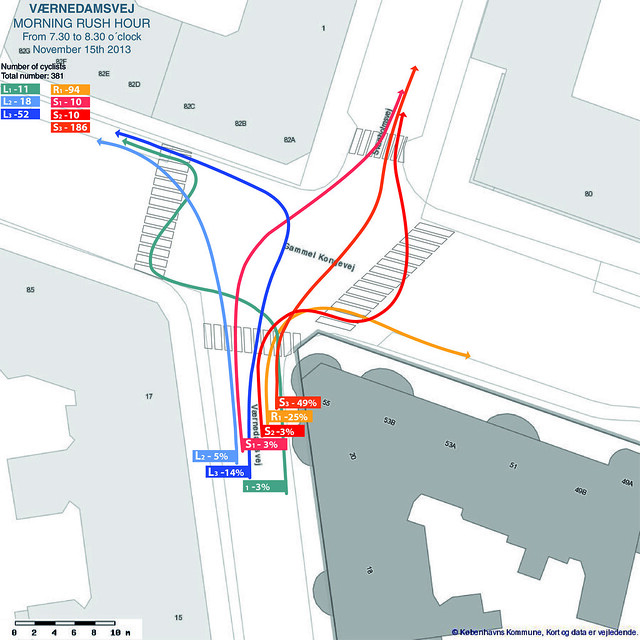
Going straight down Svanholmsvej
A majority of the bicycle users (54%) heading out of Værnedamsvej at the north end during the morning rush hour continue straight down Svanholmsvej (Sn). Despite that sounding like a pretty straightforward approach, bicycle users followed three different Desire Lines in this direction.
The main trajectory (S3) is used by 90% of the cyclists going straight down Svanholmsvej. Once the light turned green, bicycle users simply followed a straight line across the intersection.
The second Desire Line (S2) shows that bicycle users swing to the right in order to follow the crosswalk in order to cross the intersection. The observations didn’t show any obvious reason for this behaviour. We think it is because the intersection is a large expanse of unmarked space due to the irregularities in the layout. Feeling like you are alone in a big empty space may cause bicycle users to seek some structure, like following the crosswalk, in order to indicate to the other traffic users what their intentions are.
Some cyclists (5% of all commuters going straight) made a bend to the left (S1). Most of the bicycle users that followed this Line were proceeding faster than normal through the yellow light. They made this bend in their trajectory in order to avoid the cars that had already started off the light on the right on Gammel Kongevej.
In conclusion, even though the two streets are not aligned, there are no specific rearrangements to implement regarding this direction. 90% of the bicycle users moving from Værnedamsvej into Svanholmsvej follow the simplest, most straightforward trajectory across the intersection.
Turning left onto Gammel Kongevej
The map shows that 21% of the cyclists leaving Værnedamsvej made a left turn up Gammel Kongevej, following three different Desire Lines.
Usually when people in Copenhagen make a left turn at an intersection, they perform the so-called “Copenhagen Left” - or box turn. This involves crossing the intersection and waiting ahead of the crosswalk to continue to the left.
At this location, because of the crooked design of the streets, Vœrnedamsvej isn't on a direct axis to Svanholmsvej, bicycle users avoid the unnecessary detour and make a direct turn. 64% of all people turning left aim for the corner of the street, which is the direct line (L3).
This seems like the most logical route to take, except that the bicycle users end up crossing the flow of car traffic. There is nothing at the intersection to communicate with the motorised vehicle drivers - like blue bike lanes on the ground.
The 22% of all bicycle users making a left turn onto Gammel Kongevej (L2) appeared to have a higher speed than most other cyclists. This appears to cause them to ‘cut corners’.
The trajectory L1 shows people using the crosswalk on the left. This often happens when bicycle users arrive at the intersection when the pedestrian light is green. They directly cross Gammel Kongevej by acting as a pedestrian: slowing down to pedestrian speeds or swinging one leg off and proceeding like a scooter. Once again, we are convinced that this behaviour is due to the size and vagueness of the intersection, causing them to seek structure.
In conclusion it is, in this situation, complicated and unlikely that we can force the cyclists to make the usual Copenhagen Left. Making a direct turn is quite safe, but the coordination with the cars can be improved.
Turning right onto Gammel Kongevej
25% of the bicycle users who leave Værnedamsvej turned right on Gammel Kongevej. They followed the traditional Desire Line for right turns and this trajectory does not call for any remarks. There is the question of turning right on red, however, which the police in Copenhagen will not allow, even though it is a bicycle-friendly feature in Paris and other French cities, Basel and many Belgian cities. As we often see, bicycle users turned right on red at this intersection, doing so slowly and always prioritising pedestrians. All very undramatic.
Northern intersection - Heading into Værnedamsvej
This map shows data of all the cyclists entering Værnedamsvej at the north side during the morning rush hour. In total, we counted 230 cyclists and they arrived in the street from three different directions:
-
right turn from Gammel Kongevej
-
straight across from Svanholmsvej
-
right turn from Gammel Kongevej

Right turn from Gammel Kongevej
The majority of all bicycle users turning into Værnedamsvej made a right turn from Gammel Kongevej (65%). The people entering the street from this direction used the Desire Line Ln. This route does not show any complications.
Coming straight from Svanholmsvej
Only 12% of bicycle users entering Værnedamsvej come from Svanholmsvej (Sn). Svanholmsvej is a one-way street for all traffic (south to north) but it is often used by cycling citizens in both directions. Bicycle users who come out have to wait at the corner of Svanholmsvej and Gammel Kongevej.
It is not an official waiting area for cyclists doing the Copenhagen Left, which is obviously an oversight by the City of Frederiksberg. Because the sidewalk is extended here, and the street is narrow, there is not a lot of space for waiting bicycle users. Also, there is no traffic light for bicycle users wishing to go down Værnedamsvej. This lack of space causes a conflict between the waiting bicycle users and cars entering Svanholmsvej. It is unclear to all traffic users what the hierarchy is here, with no clear markings.



Bicycle users waiting at Svanhomlsvej corner and using the pedestrian crossing light to know when they must cross the boulevard.
Turning left from Gammel Kongevej
23% of people turning into the Værnedamsvej turn left from Gammel Kongevej. The map shows us that there are four different ways to take this route.
At this intersection, the important point to figure out was how many bicycle users perform the Copenhagen Left to cross this intersection?
In fact, 50% did so, by waiting at the corner of the Svanholmsvej for the next green light. Fewer people (27%) use the crosswalks – either the first or the second one - to get across Gammel Kongevej when the pedestrian light is green.
There is a very small number of people who directly cross the entire intersection. This is only done when there is a gap in car traffic and the passage appears safe.
Generally speaking, the data collected during the afternoon rush hour show the same Desire Lines but the proportions are different.
The trajectories and the behaviour of the bicycle users at this intersection allow drawing the two following main conclusions:
First, the Copenhagen Left is a major and effective feature of the cycling habits in the city - as well as being the law – and few cyclists bother to cross an intersection directly. When the streets are not aligned it remains an habit for half of the cyclists to do the Copenhagen Left even if no bike box is painted on the ground.
Secondly, at the corner of Svanholmsvej and Værnedamsvej the space is too narrow to accommodate the number of cyclists waiting. It creates a potential conflict with the cars.
Part 3: The Desire Lines tool applied to a complex intersection (Værnedamsvej, Vesterbrogade, Frederiksberg Allé)
Here we get to focus on a major abberration in the street layout of Copenhagen. An intersection where bicycle users - and basically everyone else - have no normal way to cross the intersection. Indeed, the junction Værnedamsvej, Vesterbrogade and Frederiksberg Allé, is complex and not completely regulated by traffic lights. Generally, it's a bit weird.
What contributes to the confusion is the fact the municipal border between Copenhagen and Frederiksberg zig zags bizarrely through the area. It is also worth noting that ALL the bicycle infrastructure in place is on the Copenhagen side of the intersection. Frederiksberg hasn't bothered to do much at all. Except for seemingly wishing to priortize cars.
Here are the results of our observations made in October 2013 during the morning rush hour.
Southern intersection - Heading out Værnedamsvej
The bicycle users exiting Værnedamsvej followed an amazing 11 different Desire Lines. Compared with the less complex junction at the other end of the street, the number of trajectories recorded is more numerous (11 vs. 7). Let’s figure out what the bicycle users do when they must follow their own instinct and urban desire lines.
The 183 bicycle users observed headed to four different directions:
- turned left on Vesterbrogade (41%)
- turned right on Vesterbrogade (17%)
- headed straight across to Oehlenschlægersgade (36%)
- turned right on Frederiksberg Alle (7%) – this last Desire Line doesn't require any comment as it is the simplest one.
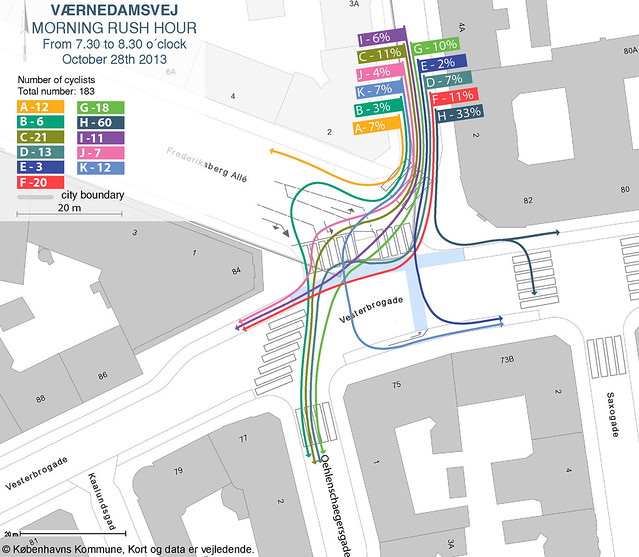
Turning left on Vesterbrogade
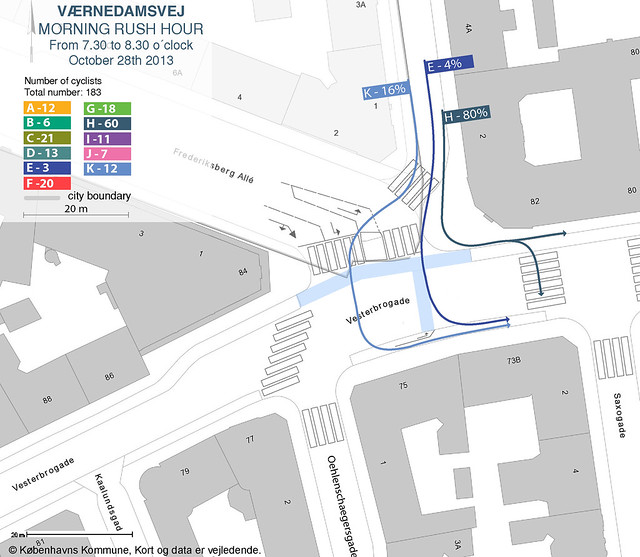
You can see the complexity of the intersection on the map. No clear, straight lines are in place. The majority of the bicycle users leaving Værnedamsvej turn left on Vesterbrogade (41%) - heading for the city centre. They cannot, however, reach the traffic light without using the crossing or cycling against traffic. That’s why 80% of these bicycle users bike or walk their bike on the sidewalk in order to reach the pedestrian crossing further down Vesterbrogade. Indeed, they try to follow the shortest trajectory and head normally towards the direction they want to reach without making a detour. Classic Desire Line behaviour.
In the first Desire Lines report – the Choreography of an Urban Intersection, we created 3 categories of cyclists: the Conformists, the Momentumists and the Recklists. Once again we noticed that only a very few “recklists” take a direct bend through the intersection (Line E).
Turning right on Vesterbrogade
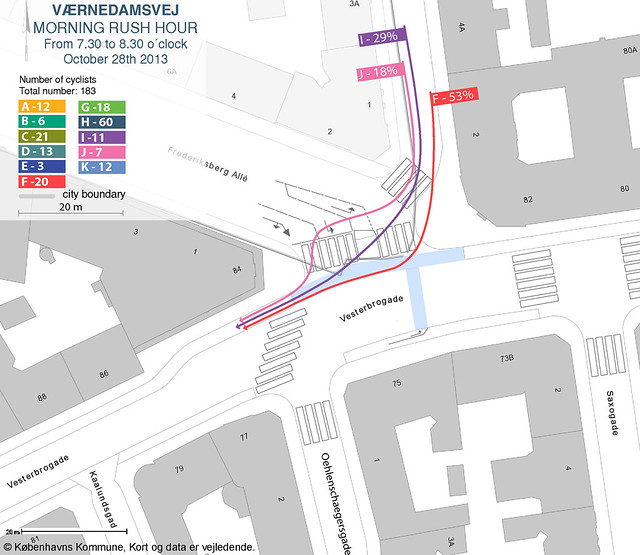
Basically, there is no legal and safe way to turn right on Vesterbrogade by bike. All three Desire Lines used by the bicycle users break the traffic rules. Only those bicycle users who get off their bike and walk on the two-stage crossing act legally.
53% of the cyclists reach the sidewalk and then the cycle track on Vesterbrogade. They wait at the traffic light and then continue straight on. It's not a bad way to do it, but it certainly isn't bicycle-friendly and it also forces them to use pedestrian space, which is at a premium here. Especially in the afternoon in this densely populated neighbourhood, when bicycle parking and a sausage wagon take up even more space.
29% use the pedestrian crossing, completely or partially. Some of them get off their bike but a majority cycles. 18% take the shorter but also less safe trajectories, cycling against the car traffic.
We noticed that when cyclists felt uncomfortable, they quite often get off the bike and act as a pedestrian. At the very least, using the pedestrian infrastructure becomes a solution for them. But is it far from the optimal solution for everyone.
Heading straight down Oehlenschlægersgade
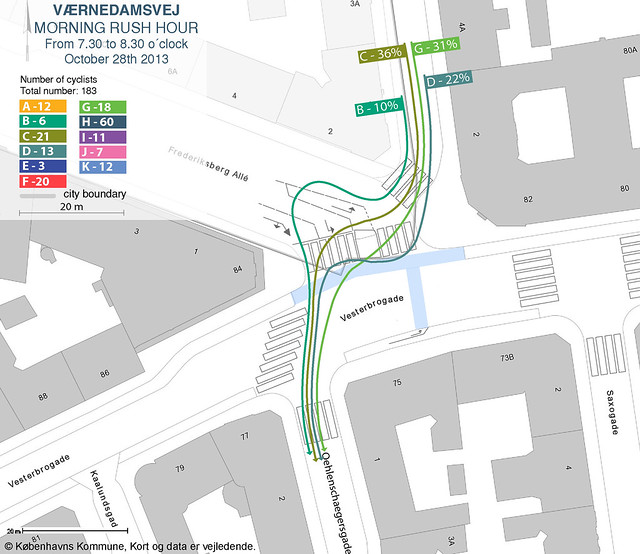
Bicycle users continuing straight on to reach Oehlenschlægersgade have the same problem as the ones turning left or right on Vesterbrogade: how on earth do you get to the traffic light? In this situation, almost half of them cycle through the car lane.
These maps clearly show that the junction is not designed for bicycle users leaving Værnedamsvej, despite the fact that it is a fairly major A to B route, as well as being a desirable destination.
Southern intersection - Heading into Værnedamsvej
For the bicycle users heading into Værnedamsvej the situation is clearly different since specific bicycle infrastructure has been designed for them. We noticed that the number of Desire Lines is less numerous (11 vs. 8). Most of all, we noticed that when bicycle infrastructure is well thought out, a clear, primary trajectory appears. One or two other minor lines are followed by a few bicycle users. It can be bicycle users using the pedestrian crossing to avoid to wait the red light or a small number of “Recklists”.

Coming from Vesterbrogade and Oehlenschlægersgade and turning left in Værnedamsvej (56% in total)
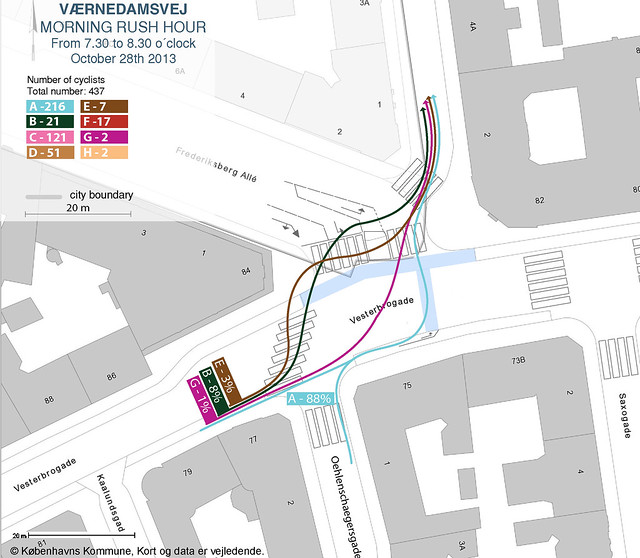
Coming from Vesterbrogade and turning right into Værnedamsvej (32% in total)

Coming from Frederiksberg Allé and turning left into Værnedamsvej (12% in total)

In addition, these numbers allow us to determine that, in the morning, bicycle users head in a clear, main direction: 30% of the cyclists head out of Værnedamsvej at this intersection and 70% enter the street. The street is an important east-west route for bicycle users.
Part 4 - The Copenhagenize Fixes - The Intersections
At CopenhagenizeDesign Co. we certainly trust bicycle users' abilities to ride on the safest, easiest and quickest routes. The key to our Fixes is almost always found in our observations of the Desire Lines of the bicycle users and their behavior. We firmly believe that before redesiging the street the intersections on either end must be fixed. Here are our proposals.
Northern intersection: Værnedamsvej - Gammel Kongevej - Svanholmsvej
To redesign this intersection we will use respect the Desire Lines of the bicycle users who use it. We'll propose changes to the infrastructure to maximise the safety of the intersection and make the wayfinding more clear.
Our Desire Lines analysis shows that there are two problems caused by the asymmetrical nature of the intersection Værnedamsvej and Gammel Kongevej:
1. For bicycle users leaving Værnedamsvej a usual Copenhagen Left is unnatural, causing bicycle users to make a direct turn. This seems a safe route, but could be better communicated to motorists.
2. The end of the Svanholmsvej is narrow, causing a lack of space for the waiting bicycle users.
We propose rearrangements mostly based on the traditional painted bicycle lanes in order to organise the intersection. Further down at the junction between Gammel Kongvej and Alhambravej, a blue lane has been painted on the ground to encourage cyclists to make a safe Copenhagen Left.

Here, on Værnedamsvej, without questioning the classic and specific way to turn left at an intersection, we prefer to accept the fact that bicycle users turn directly. Indeed, based on our observations, 0% of cyclists make the two-stage turn. Moreover, we noticed that bicycle users have a tendency not to wait on the right side on the street, since they know that no cars can turn in the street. So they wait at the traffic light in the middle of street ready to turn left.

In order to improve the relation between the cars and the bikes, we suggest to create a bike box in front of the traffic light. We're not a big fan of bike boxes, but this is one situation where it will work. Bicycle users will have the priority over the cars and will start turning at the intersection before them. This infrastructure is not usual in the streets of Copenhagen except at some T-intersections, but here it a way to replace the two-stage left turn.
Currently, they use the pedestrian signals on the other side of the street to figure out when they can cross the intersection. It's a bit of a dodgy situation. Creating a cycle track heading north to south on Svanholmsvej is a solution. This would involve removing the car parking on the left side of the street and it must be analysed at the scale of the district.
Southern intersection - Værnedamsvej – Vesterbrogade – Frederiksberg Allé
At the intersection between Værnedamsvej, Vesterbrogade, Frederiksberg Allé, it is atypical that so many cyclists use the cross walk and the sidewalk. We can consider this behaviour as a sign pointing out that this intersection does not meet cyclists' needs.
Actually, the Desire Lines' observation shows that this intersection is not at all designed for cyclists leaving Værnedamsvej. The main issue is to design an intersection that allows the cyclists turning right on Vesterbrogade and crossing it.
To fix this abnormality in the City of Cyclists, here are our suggestions:
- Moving back the traffic light for the cars
- Making space for the bicycle users in front of the cars
- Reducing the width of the pedestrian crossing
- Setting up a traffic light for bikes at the end of Værnedamsvej and another one at the end of Frederiksberg Allé. These traffic lights will turn green for the cyclists in the same time as the light dedicate to the cyclists on Vesterbrogade, when all the traffic lights for the cars are red.
Because of the complexity of this intersection a temporary solution tested during a few months while Municipalities analyse the behaviour of the cyclists, pedestrians and car drivers may be required.

Part 5 - The Copenhagenize Fixes - The Street
Here we are. Bicycle users can enter Værnedamsvej and leave it in good shape. Now it's time to showcase our proposals to redesign this lovely 12 meter wide, neighbourhood street.
Here is our vision: making clear space for bicycle users on the road, creating parking for bikes (which doesn't exist right now, except in the adjoining street Tullinsgade) and improving space for the pedestrians.
Here are the proposals in 4 steps:
-
Creating a 30 km/hour zone in order to increase the safety of the bicycle users and pedestrians
-
Turning the entire street into one-way for cars
-
Creating a designated, contraflow bike lane for the bicycle users heading against the one way
-
Creating parklets and parking zones alternating between both sides of the street, resulting in a curving car lane that forces motorists to slow down. The parking zones for cars are located only along the car lane. In front of the school, instead of a parklet, the pavement is extend in order to create space for the children hanging out after school.
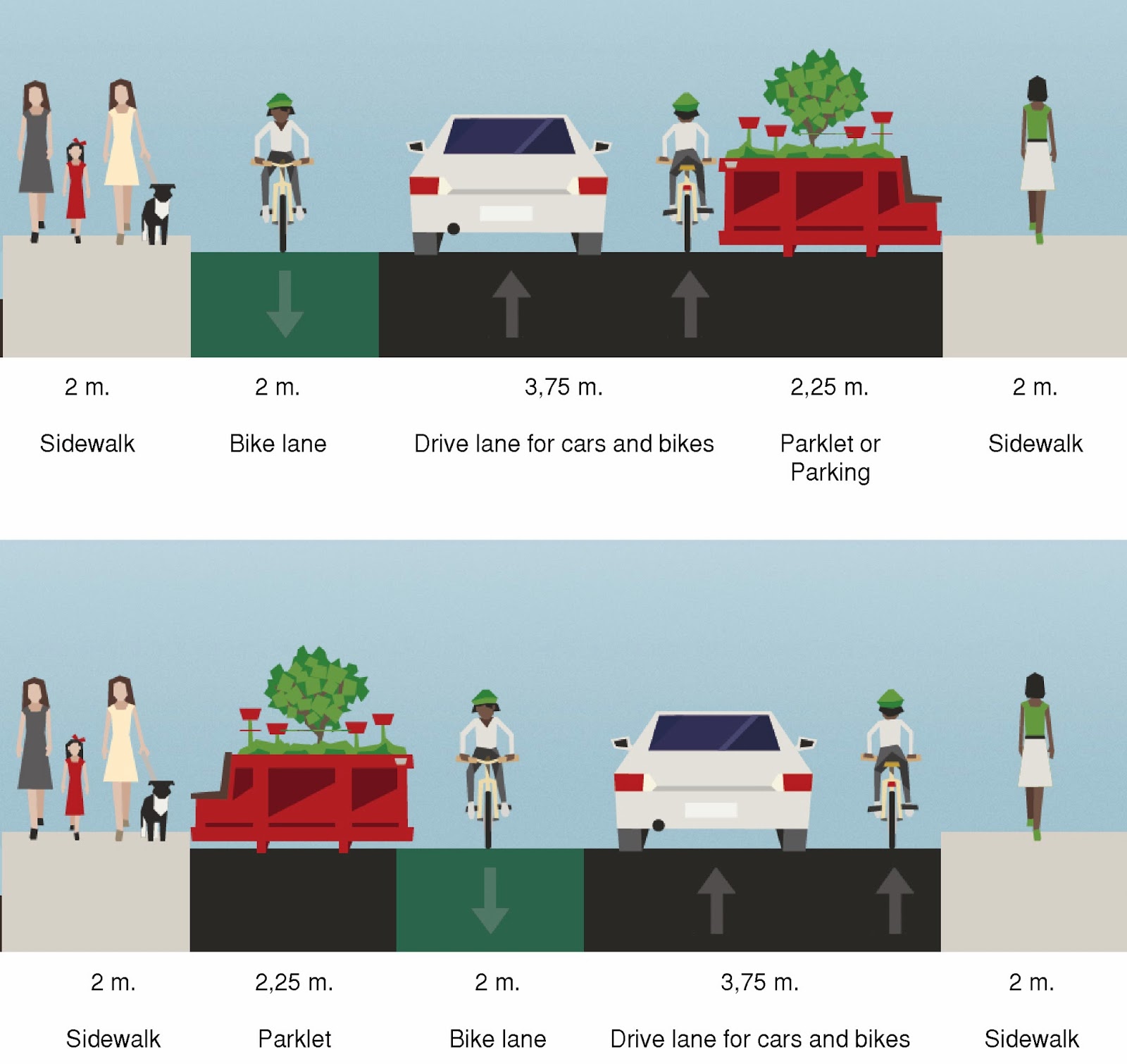
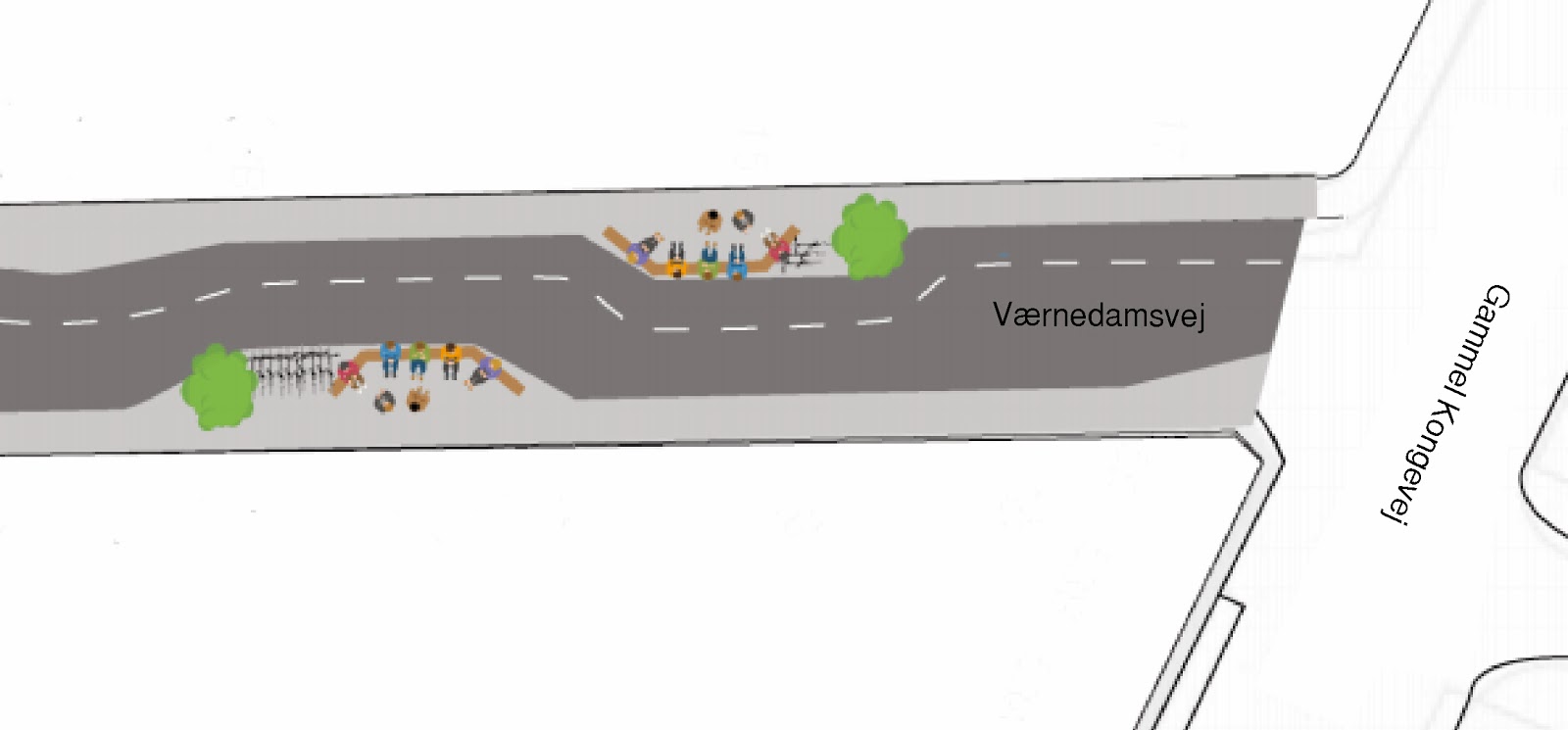
Here is our vision of a parklet including bike racks.

This rearrangement is quite similar to the layout the Copenhagen Municipality made in Elmegade in Nørrebro. Moreover, another solution would be to turn the street into a bike street, giving to the cyclists the priority towards the cars - who are in the minority on this street.
We have decided not to propose to turn Værnedamsvej into a shared-space street with a reduced speed for cars and space for pedestrians and cyclists on the whole width of the street. Indeed, we consider the number of cyclists too high for creating a peaceful environment for all the users of the street.




